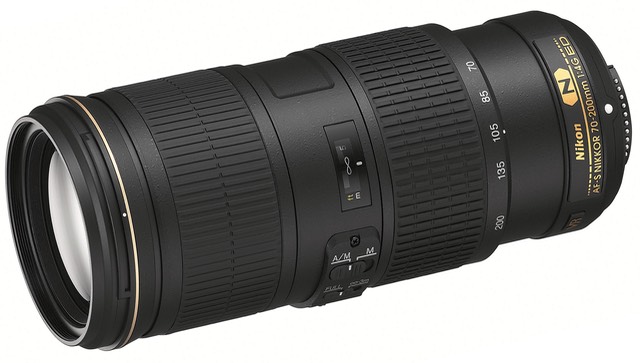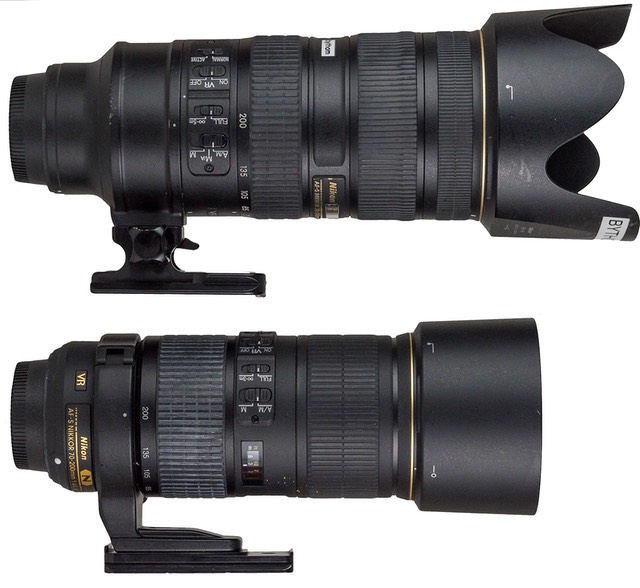
What is It?
The 70-200mm f/4 rounds out the trio of slower aperture zooms that Nikon makes (16-35mm, 24-120mm), probably in response to the f/4 zoom trio that Canon produced. The 70-200mm f/4G VR is an FX lens, and a smaller and lighter partner to the 70-200mm f/2.8G VR II.
Nikon’s own marketing gets it right with this lens: “strikes an ideal balance…” Yes, indeed. Far more so than most Nikon lenses, the 70-200mm f/4G is a very well-rounded, well-behaved, well-performing lens.
The optical construction is still pretty complex: 20 elements in 14 groups, with three ED elements in the mix. Nano coating, 9-blade aperture diaphragm, and a VR system rated at 4 stops CIPA combine with internal focusing and zooming to make this somewhat compact lens stay compact at all times while still providing high performance. The 70-200mm f/4 does not extend or rotate during focus or zooming.
"Somewhat compact" in this case means 3.1 x 7” (78 x 178.5mm) and 30 ounces (850g). Up front we’ve got 67mm filters and a smallish HB-60 bayonet hood. If you’ve had any experience with the 70-200mm f/2.8 lens you’ll immediately be struck by how just trimming one stop from the aperture made this new lens clearly smaller and lighter (see below). So much so that I reach for the f/4 version first these days and leave the f/2.8 at the studio unless I know I really need its light gathering gain.
Minimum focus is 3.28 feet (1m), and the maximum reproduction ratio is 1:3.6. This lens doesn’t have the extreme focal length breathing of its bigger sibling. Focusing is internal, as already noted.
The zoom ring is marked at 70mm, 85mm, 105mm, 135mm, and 200mm focal lengths, and goes from 70 to 200mm in less a quarter turn. The focus position window has no depth of field or IR markings, and has 3.5, 4, 5, 7, and 10 foot markings, plus 1, 1.2, 1.5, 2, 3, and 5m markings, as well as infinity. The focus ring goes from minimum to maximum in just over a quarter turn.
On the side, we have four two position switches between the zoom and focus rings:
- A/M or M focus mode
- Full or infinity to 3m focus restriction
- VR on or off
- Normal or Active VR mode

It’s useful to consider some of the key differences between the current 70-200mm f/2.8 (top) and f/4 (bottom) lenses:
- The f/4 version comes in at 24.3 ounces (690g) lighter
- The f/4 version is 1” (27mm) shorter and .3” (9mm) smaller in diameter
- The f/4 version focuses to 39” compared to 55” for the f/2.8 version
- The f/4 version has far less focal length breathing than the f/2.8 version
- The f/4 version takes 67mm filters instead of 77mm
The penalty for all those improvements is that you lose a stop of light.
Nikon’s page for the lens is here. The lens is made in Thailand, and sells for US$1400.
Source of the review sample: personal purchase. Results compared to two other sample lenses available to me.
How’s it Handle?
Right up front you have to speak to the smaller size and weight. Perhaps on the big D4/D5 type body the difference isn’t going to seem meaningful, but on the smaller bodies it absolutely is. This f/4 lens packs into smaller bags than the f/2.8 and gives you less overall weight to your bag, too. So those looking into DX or the lighter FX bodies will, I think, naturally gravitate to this lens just because of its more diminutive physical attributes.
Both the focus and zoom rings on my sample are very smooth and fairly quiet. The focus ring is at the front of the lens, the zoom at the back (camera side). While they use slightly different textures in the rubber, it’s near impossible to distinguish between the rings except by position.
As I noted, the zoom ring goes from 70-200mm in less than a quarter of a turn. So the combination of smooth and short distance means I can almost reliably move focal length with just a touch of my thumb, a bit unusual for Nikkor designs, but very welcome.
The optional and removable tripod collar is shared with the 300mm f/4E. As usual with Nikon’s designs these days, it’s almost impossible to get the collar locked tight enough to the lens to form an absolute secure connection, let alone one that will withstand any tripod slap. If I grab the foot and push towards the lens, I can move the collar. Sadly, that makes it near useless.
The Kirk collar is a better choice than Nikon’s, though I still think you’d want to put some downward pressure on the top of lens to make sure that it’s front support engages the lens completely. The Really Right Stuff collar makes a tighter fit than Nikon’s, but still can fulcrum on you if you’re not careful to get it fully locked down.
That said, I don’t tend to shoot this lens with the tripod collar. The smaller size and weight of the lens means that it is very comfortable to hand hold.
How’s it Perform?
Autofocus performance is snappy, nearly on par with the f/2.8 lens, which is about as good as it gets.
On DX cameras, I can’t really find fault with the sharpness from 70-135mm. It’s excellent edge to edge even wide open, though f/8 might be the best aperture by a slight margin. At 200mm, you really need to stop down to f/5.6 to get excellent results; wide open I’d just call it very, very good. The corners at 200mm were down from the center, I’d call them good.
As usual, we see a bit more complexity to the optics on the FX bodies. Strangely, the extreme corners just never approach the central region from 70-105mm. There’s always just a bit of degradation at the edges, indeed, even stopped down to f/8 at some focal lengths. Yet, at 135-200mm, I’d call the edge to edge performance very good and close to the central sharpness, even wide open.
Yeah, that’s weird. I thought my test results were wrong when the corners at 200mm on a DX body seemed worse but were okay on an FX body. So I tested again and got the same thing. Just goes to show that there are more variables in play than just the lens sometimes. I chalk such things up to slight variations in sensor filtration thickness coupled with the optical design.
Overall, I’d tend to say the 70-200mm f/4G is very good on the high resolution bodies such as the D810, and excellent on the high resolution DX bodies. The slight issues at the corners don’t bother me much for telephoto use.
Chromatic aberration is absolutely present in modest amounts throughout the focal length range, though it decreases a bit as you zoom in. No real shocks here, and well within the realm of easily fixable.
Vignetting was also good, with the FX bodies showing maybe two-thirds of a stop wide open at 70mm, a full stop at 200mm. At f/5.6 I’d call vignetting ignorable on FX bodies. On DX bodies its mostly ignorable even wide open.
Distortion was a bit surprising, and complex, though very low in amount. The lens never has distortion in large quantity (always less than 2%). However, on FX bodies I can see that the distortion is not perfectly linear. At 70mm, everything is clearly barrel distortion. At 85mm there’s almost no distortion. Above that we get this strange pattern: the extreme corners move to slight pincushion distortion while the central area still has something like a small amount of barrel distortion. On DX bodies I’d say the distortion is probably ignorable.
You probably want to know how the f/4 performs overall versus the f/2.8. Okay. Sharpness tends to be similar in the lower focal length range between both lenses, but the f/4 is clearly worse than the f/2.8 at the long focal lengths on my samples when used at f/4, especially in the extreme corners (note: I’ve seen tests from others that don’t show this; could be sample variation). I’d have to say that my f/2.8 is a bit sharper on average at f/4 than my f/4 sample. Not enough to make me pick the f/2.8 over the f/4. The only reason I feel compelled to pick up and use the f/2.8 is f/2.8.
Someone asked about VR performance after I posted the initial review. Nikon rates the 70-200mm f/2.8 at 3.5 stops CIPA, the 70-200mm f/4 at 4 stops CIPA. What you actually get out of VR is highly susceptible to your handling and whether or not you’re moving when you use it.
Yes, I do think that the f/4 lens seems a bit more “stable” than the f/2.8 version, though it’s more subtle than I think most people are talking about. Simply put, the f/4 lens is easier to handhold well (especially if you don’t put the optional tripod collar on), so I think some of the “improvement” that many claim over the f/2.8 might simply be that they’re not handling as much mass and girth.
That said, in as best as I can manage like-versus-like testing, the f/4 VR performance does seem to be a bit better than the f/2.8’s. So Nikon’s ratings are probably accurate: the f/4 is a bit better than the f/2.8 in VR.
Final Words
If you don’t need f/2.8, you don’t need the more expensive lens, basically. The 70-200mm f/4G is has no significant flaws to speak of, resolves well on even the highest megapixel count bodies, yet saves you size and weight over its older sibling.
In particular, the 70-200mm f/4 is a nice pairing with DX bodies, such as the D7200 or D500. But I tend to shoot with it even on my D810.
The catch is this: what are you using a telephoto lens for? Sports? Wildlife? Well, there will be times when f/2.8 is definitely something you miss if you buy the 70-200mm f/4. It’s not an indoor sports lens unless you’ve got a well-lit venue and a body that can shoot high ISO well. Likewise, edge of day in the wilds can force you to push your ISO values up because f/4 just isn’t going to hold high shutter speeds at dawn or dusk.
So there’s a little bit of a “fair weather friend” aspect to this lens. If you’ve got enough light, it’s an excellent performer. If you don’t have much light, you’re going to wish you had the f/2.8 version.
Which is why a number of us have both versions.
Then there’s price. You pay US$700 for one stop of light (and bad focal length breathing, which means you don’t really have 200mm at close distances with the more expensive lens). Of course, if you want a tripod collar for the 70-200mm f/4, you have to add some bucks (hint: B&H sells a Vello replacement collar for much less than Nikon’s version. See ad, below.)
Still, this is a good lens. Don’t ignore it because it isn’t f/2.8.
Recommended (2016 to present)
Support this site by purchasing from the following advertiser:
